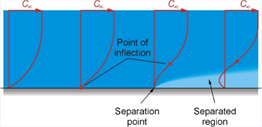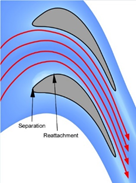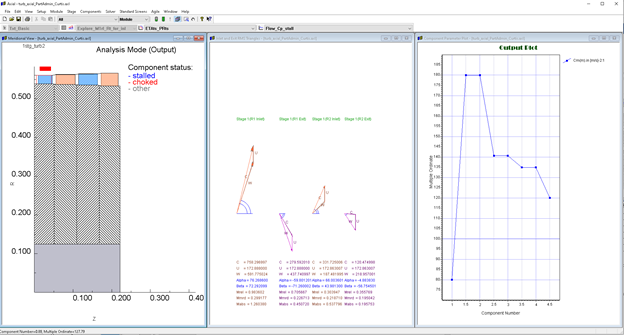In the world of aerodynamics, there are several branches and sub-branches of different types of aerodynamics. In the big picture the field of aerodynamics can be broken down into external and internal aerodynamics. External aerodynamics is thought of external flow around an isolated body, with the typical example being flow around an aircraft wing section, or perhaps around an automobile. There is typically a far field ambient condition, with an isolated body moving through the field (or you can view it as the fluid moving over the body). Internal aerodynamics is thought of as a flow moving through some confined space or passage, with a prime example being flow through turbomachinery, such as a compressor or turbine. There are other ways to classify aerodynamic flow, such as subsonic flow (Mach No. <0.8, including low Mach No. incompressible flow, say Mach No. <0.3), transonic flow (around Mach No. = 1, say 0.8 to 1.2), supersonic flow (Mach No. > 1.2), and even hypersonic flow (Mach No. >5). Turbomachinery design encompasses the first three types of flow regimes, subsonic through supersonic. So in general, turbomachinery aerodynamics is predominately internal flow, over a range of Mach Numbers.
Putting a lens on turbomachinery, a further natural breakdown can be characterized in the big picture by component, compressor versus turbine design, where compressors, fans, blowers, and pumps fall under the general category of devices adding energy to fluids, while turbines extract energy from fluids. Turning to the related aerodynamics, one overarching aerodynamic difference between these two categories of turbomachinery is that in the compressor category the pressure of the fluid is typically increasing through the component (with some exceptions), while in a turbine the pressure is decreasing (again, with some exceptions). When it comes down to detail design of stages and blading, one result is that compressor aerodynamic designers typically work with adverse (diffusing) pressure gradients where the static pressure levels are increasing in the direction of flow, while turbine aerodynamic designers work with accelerating flow fields, with the static pressure dropping. From a pure aerodynamic viewpoint, it’s hard to argue that working with adverse pressure gradients and diffusing flow is not a more difficult challenge than working with accelerating flow. Corresponding fluid dynamic characteristics such as thickening boundary layers, sensitivity to surface curvature, and sensitivity to inlet conditions can all lead eventual flow separation, if not higher losses and blockage.

Boundary layer behavior with C∞ decreasing in the direction of flow
In turbine aerodynamic blading design, accelerating flow typically shuts down boundary layer growth, and reduces sensitivity to variations such as upstream velocity flow fields. While different aerodynamic design approaches in turbine blade rows (such as forward-loaded versus aft-loaded blading) can still impact secondary flow and overall losses, the improved aerodynamics leads to increased stage loading and higher performance in turbines. Indeed, for the same pressure ratio, compressors typically have more stages than turbines. To be clear, even turbine airfoils, where the flow is generally accelerating (or at least not diffusing) on a bulk basis from inlet to exit, might have areas of local diffusion, perhaps in regions of locally high curvature, downstream of the passage throat, or at off-design conditions, and can even have areas of local separation and reattachment, but in general compressor airfoil designers deal with these issues related to diffusing flow much more extensively than turbine designers.

Turbine airfoil with an area of local separation and reattachment
But before tossing the prize to the compressor designers, there is more to the question than just adverse pressure gradients. Take for example gas turbine engines with hot turbine sections and cooled blading. An aerodynamic turbine designer might want thin blade sections but is often stuck with relatively thick mid-chord blade sections to allow for internal cooling flow passages, as well as thick blade trailing edges to either minimize cracking or allow for trailing edge cooling flow discharge, leading to negative effects such as blockage and mixing losses at the blade exit. All of these constraints make achieving good blade aerodynamic loadings and performance much harder. And the addition of cooling flows being ejected onto the surface of the cooled turbine blading does not help the aerodynamics, although at least both the aerodynamic designer and the cooling/heat transfer analyst want the cooling flow to lay down and stay attached to the blade surface, and not cause any disruption or separation of the boundary layer.
So which is harder to design aerodynamically, a compressor or a turbine? Fundamentally the aerodynamics are tougher in the compressor. While modern compressor design software and tools such as CFD have made compressor design less risky, when I think of turbomachinery aerodynamic design challenges, I have the greatest respect for compressor designers from back in the ‘old days’ before modern computer analysis (or before any computer analysis), and the great job they did getting good or at least adequate performance from multi-stage axial compressors, where they had to get individual blade row design right, as well as stage matching over many stages. Extensive testing was needed, but also a good fundamental understanding of the aerodynamics. But turbine aerodynamic designers are not left off-the-hook, as the expectations for higher performance and reduced stage count push the turbine designers to their limits too. Both compressor and turbine aerodynamic design present challenges, and both required good aerodynamic design judgement.
Here at Concepts NREC we have extensive experience with both compressor and turbine design, in the Engineering group doing design work, and in the Software (CAE) group developing and supplying design software to our clients, including for cooled turbine airfoil design. So, whether a compressor or turbine design is your need, either just the aerodynamic design or a full up design including mechanical and prototyping, please contact us if you need help.
#turbomachinery #compressor #turbine






